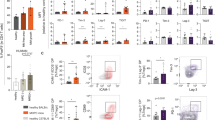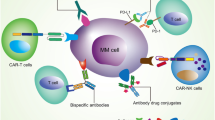Abstract
Multiple myeloma is characterized by the proliferation of clonal plasma cells that have a heterogeneous expression of various cell surface markers, precluding successful use of monoclonal antibodies for therapeutic targeting of the tumor cell. Thymoglobulin (rabbit-derived polyclonal anti-thymocyte globulin), by virtue of its method of preparation, contains antibodies against several B-cell and plasma cell antigens and offers an attractive option for immunotherapy of myeloma. Here, we demonstrate potent anti-myeloma activity of the rabbit anti-thymocyte globulin preparation Thymoglobulin in vitro and in vivo in an animal model of myeloma. Thymoglobulin was able to induce dose- and time-dependent apoptosis of several myeloma cell lines, including those resistant to conventional anti-myeloma agents. Importantly, the anti-myeloma activity was preserved even when myeloma cells were grown with different cytokines demonstrating the ability to overcome microenvironment-mediated resistance. Thymoglobulin induced apoptosis of freshly isolated primary myeloma cells from patients. Using a competitive flow cytometric analysis, we were able to identify the potential antigen targets for Thymoglobulin preparation. Finally, in a plasmacytoma mouse model of myeloma, Thymoglobulin delayed the tumor growth in a dose-dependent manner providing convincing evidence for continued evaluation of this agent in the clinic in patients with myeloma, either alone or in combination with other agents.
This is a preview of subscription content, access via your institution
Access options
Subscribe to this journal
Receive 12 print issues and online access
$259.00 per year
only $21.58 per issue
Buy this article
- Purchase on Springer Link
- Instant access to full article PDF
Prices may be subject to local taxes which are calculated during checkout





Similar content being viewed by others
References
Swinnen LJ, Costanzo-Nordin MR, Fisher SG, O'Sullivan EJ, Johnson MR, Heroux AL et al. Increased incidence of lymphoproliferative disorder after immunosuppression with the monoclonal antibody OKT3 in cardiac-transplant recipients. N Engl J Med 1990; 323: 1723–1728.
Bonnefoy-Berard N, Flacher M, Revillard JP . Antiproliferative effect of antilymphocyte globulins on B cells and B-cell lines. Blood 1992; 79: 2164–2170.
Shah A, Nadasdy T, Arend L, Brennan J, Leong N, Coppage M et al. Treatment of C4d-positive acute humoral rejection with plasmapheresis and rabbit polyclonal antithymocyte globulin. Transplantation 2004; 77: 1399–1405.
Zand MS, Vo T, Huggins J, Felgar R, Liesveld J, Pellegrin T et al. Polyclonal rabbit antithymocyte globulin triggers B-cell and plasma cell apoptosis by multiple pathways. Transplantation 2005; 79: 1507–1515.
Ayuk FA, Fang L, Fehse B, Zander AR, Kroger N . Antithymocyte globulin induces complement-dependent cell lysis and caspase-dependent apoptosis in myeloma cells. Exp Hematol 2005; 33: 1531–1536.
Zand MS, Vo T, Pellegrin T, Felgar R, Liesveld JL, Ifthikharuddin JJ et al. Apoptosis and complement-mediated lysis of myeloma cells by polyclonal rabbit antithymocyte globulin. Blood 2006; 107: 2895–2903.
Tassone P, Goldmacher VS, Neri P, Gozzini A, Shammas MA, Whiteman KR et al. Cytotoxic activity of the maytansinoid immunoconjugate B-B4-DM1 against CD138+ multiple myeloma cells. Blood 2004; 104: 3688–3696.
Stevenson FK, Bell AJ, Cusack R, Hamblin TJ, Slade CJ, Spellerberg MB et al. Preliminary studies for an immunotherapeutic approach to the treatment of human myeloma using chimeric anti-CD38 antibody. Blood 1991; 77: 1071–1079.
Goldmacher VS, Bourret LA, Levine BA, Rasmussen RA, Pourshadi M, Lambert JM et al. Anti-CD38-blocked ricin: an immunotoxin for the treatment of multiple myeloma. Blood 1994; 84: 3017–3025.
Peng KW, Donovan KA, Schneider U, Cattaneo R, Lust JA, Russell SJ . Oncolytic measles viruses displaying a single-chain antibody against CD38, a myeloma cell marker. Blood 2003; 101: 2557–2562.
Perez-Andres M, Almeida J, Martin-Ayuso M, Moro MJ, Martin-Nunez G, Galende J et al. Clonal plasma cells from monoclonal gammopathy of undetermined significance, multiple myeloma and plasma cell leukemia show different expression profiles of molecules involved in the interaction with the immunological bone marrow microenvironment. Leukemia 2005; 19: 449–455.
Szczepek AJ, Belch AR, Pilarski LM . Expression of IL-6 and IL-6 receptors by circulating clonotypic B cells in multiple myeloma: potential for autocrine and paracrine networks. Exp Hematol 2001; 29: 1076–1081.
Uchiyama H, Barut BA, Chauhan D, Cannistra SA, Anderson KC . Characterization of adhesion molecules on human myeloma cell lines. Blood 1992; 80: 2306–2314.
Okada T, Hawley RG, Kodaka M, Okuno H . Significance of VLA-4-VCAM-1 interaction and CD44 for transendothelial invasion in a bone marrow metastatic myeloma model. Clin Exp Metastasis 1999; 17: 623–629.
Sanz-Rodriguez F, Ruiz-Velasco N, Pascual-Salcedo D, Teixido J . Characterization of VLA-4-dependent myeloma cell adhesion to fibronectin and VCAM-1. Br J Haematol 1999; 107: 825–834.
Vacca A, Di Loreto M, Ribatti D, Di Stefano R, Gadaleta-Caldarola G, Iodice G et al. Bone marrow of patients with active multiple myeloma: angiogenesis and plasma cell adhesion molecules LFA-1, VLA-4, LAM-1, and CD44. Am J Hematol 1995; 50: 9–14.
Sanz-Rodriguez F, Teixido J . VLA-4-dependent myeloma cell adhesion. Leukemia Lymphoma 2001; 41: 239–245.
Sanz-Rodriguez F, Hidalgo A, Teixido J . Chemokine stromal cell-derived factor-1alpha modulates VLA-4 integrin-mediated multiple myeloma cell adhesion to CS-1/fibronectin and VCAM-1. Blood 2001; 97: 346–351.
Damiano JS, Cress AE, Hazlehurst LA, Shtil AA, Dalton WS . Cell adhesion mediated drug resistance (CAM-DR): role of integrins and resistance to apoptosis in human myeloma cell lines. Blood 1999; 93: 1658–1667.
Matsui W, Huff CA, Wang Q, Malehorn MT, Barber J, Tanhehco Y et al. Characterization of clonogenic multiple myeloma cells. Blood 2004; 103: 2332–2336.
Lin P, Owens R, Tricot G, Wilson CS . Flow cytometric immunophenotypic analysis of 306 cases of multiple myeloma. Am J Clin Pathol 2004; 121: 482–488.
Acknowledgements
This study was supported in part by Mayo Clinic Hematological Malignancies program (SK), and a grant from Genzyme Corp., Cambridge, MA (SK).
Author information
Authors and Affiliations
Corresponding author
Rights and permissions
About this article
Cite this article
Timm, M., Kimlinger, T., Haug, J. et al. Thymoglobulin targets multiple plasma cell antigens and has in vitro and in vivo activity in multiple myeloma. Leukemia 20, 1863–1869 (2006). https://doi.org/10.1038/sj.leu.2404359
Received:
Accepted:
Published:
Issue Date:
DOI: https://doi.org/10.1038/sj.leu.2404359
Keywords
This article is cited by
-
Polyclonal rabbit anti-murine plasmacytoma cell globulins induce myeloma cells apoptosis and inhibit tumour growth in mice
Apoptosis (2011)
-
Antitumor effects of polyclonal antithymocyte globulins: focus on B-cell malignancies and multiple myeloma
Annals of Hematology (2009)
-
Mechanisms of action of antithymocyte globulin: T-cell depletion and beyond
Leukemia (2007)



